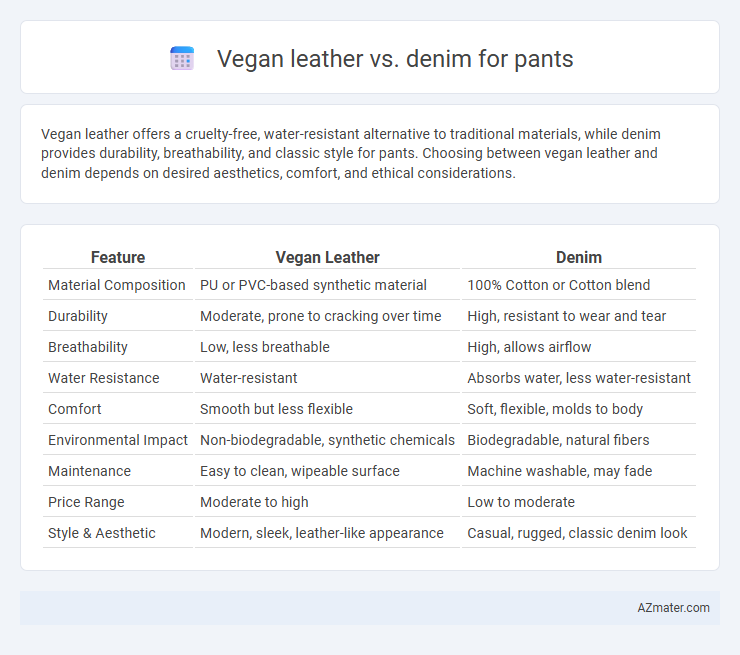Vegan leather offers a cruelty-free, water-resistant alternative to traditional materials, while denim provides durability, breathability, and classic style for pants. Choosing between vegan leather and denim depends on desired aesthetics, comfort, and ethical considerations.
Table of Comparison
| Feature | Vegan Leather | Denim |
|---|---|---|
| Material Composition | PU or PVC-based synthetic material | 100% Cotton or Cotton blend |
| Durability | Moderate, prone to cracking over time | High, resistant to wear and tear |
| Breathability | Low, less breathable | High, allows airflow |
| Water Resistance | Water-resistant | Absorbs water, less water-resistant |
| Comfort | Smooth but less flexible | Soft, flexible, molds to body |
| Environmental Impact | Non-biodegradable, synthetic chemicals | Biodegradable, natural fibers |
| Maintenance | Easy to clean, wipeable surface | Machine washable, may fade |
| Price Range | Moderate to high | Low to moderate |
| Style & Aesthetic | Modern, sleek, leather-like appearance | Casual, rugged, classic denim look |
Introduction to Vegan Leather and Denim
Vegan leather, crafted from synthetic materials or plant-based sources such as pineapple leaves or apple peels, offers an eco-friendly and cruelty-free alternative to traditional leather. Denim, composed primarily of cotton woven in a twill pattern, is a durable and breathable fabric widely used for pants due to its comfort and rugged aesthetic. Both materials present distinct environmental and functional attributes influencing consumer preferences in sustainable fashion.
Material Composition: Vegan Leather vs Denim
Vegan leather for pants is primarily made from synthetic materials such as polyurethane (PU) or polyvinyl chloride (PVC), offering a cruelty-free alternative that imitates the texture of genuine leather. Denim consists of tightly woven cotton fibers, often with added elastane for stretch, providing breathability, durability, and comfort ideal for everyday wear. The contrasting material compositions influence vegan leather's water resistance and smooth finish versus denim's natural fiber breathability and rugged texture.
Durability and Longevity Comparison
Vegan leather offers moderate durability, resisting water and stains better than denim but is prone to cracking and wear over time due to its synthetic composition. Denim, made from tightly woven cotton fibers, provides superior longevity, withstanding repeated washing and physical abrasion while becoming more comfortable with age. When choosing pants for long-term use, denim remains the preferred material for durability, whereas vegan leather suits occasions requiring a sleek look with moderate wear.
Comfort and Breathability Factors
Vegan leather, made from synthetic or plant-based materials, tends to offer less breathability compared to denim, often causing heat retention and reduced comfort during prolonged wear. Denim, crafted from natural cotton fibers, excels in breathability by allowing better air circulation, making it more comfortable in warm conditions. Comfort in vegan leather pants may improve with innovative blends, but denim remains superior for moisture wicking and temperature regulation.
Sustainability and Environmental Impact
Vegan leather, often made from plant-based or recycled materials, offers a lower carbon footprint and reduces reliance on animal agriculture compared to traditional leather, but its production can involve synthetic fibers that may hinder biodegradability. Denim requires significant water usage and pesticide application in cotton farming, contributing to environmental degradation, yet innovations in organic and recycled denim aim to minimize these impacts. Choosing between vegan leather and denim for pants depends on balancing factors such as water consumption, chemical use, durability, and end-of-life biodegradability to achieve sustainable fashion goals.
Style Versatility and Fashion Trends
Vegan leather offers a sleek, modern appeal with high versatility, seamlessly transitioning from casual to edgy styles and aligning with current sustainable fashion trends. Denim remains a timeless staple, prized for its durability and classic look, easily adapting from casual daywear to dressed-up evening outfits. Fashion trends increasingly blend both materials, with designers incorporating vegan leather accents into denim pants to create innovative and stylish hybrid pieces.
Maintenance and Care Guidelines
Vegan leather pants require gentle cleaning with a damp cloth and avoid exposure to direct heat to prevent cracking, while denim pants benefit from infrequent washing inside out to preserve color and fabric integrity. Storing vegan leather in a cool, dry place minimizes damage from moisture, whereas denim should be aired out regularly to reduce odor buildup without frequent laundering. Both materials require specific care routines to extend their lifespan and maintain appearance, with vegan leather demanding more delicate treatment compared to the durable nature of denim.
Price Point and Market Availability
Vegan leather pants typically have a higher price point due to the cost of sustainable and synthetic materials, often ranging from $80 to $200 per pair, while denim pants generally fall between $30 and $100, making denim more affordable for most consumers. Market availability favors denim, widely produced and stocked globally by numerous brands in both budget and premium segments, whereas vegan leather pants remain niche, mainly found in eco-conscious and specialty fashion outlets. The growing demand for animal-friendly materials is expanding vegan leather's presence, but denim still dominates mass-market access and pricing advantages.
Ethical Considerations and Consumer Choice
Vegan leather offers an ethical alternative to traditional leather by eliminating animal cruelty and reducing carbon emissions, while denim production involves significant water usage and pesticide application, raising environmental concerns. Consumers increasingly prioritize sustainability, driving demand for vegan leather that supports cruelty-free fashion and lower environmental impact. Ethical considerations influence choices as buyers weigh animal welfare and ecological effects against durability and style preferences in pant materials.
Conclusion: Which is Better for Pants?
Vegan leather offers a sleek, water-resistant alternative to traditional denim, appealing to those seeking cruelty-free and sustainable fashion. Denim remains the durable, breathable choice favored for comfort and versatility in everyday wear. Choosing between vegan leather and denim for pants ultimately depends on lifestyle priorities, balancing ethical considerations with practical functionality.

Infographic: Vegan leather vs Denim for Pant
 azmater.com
azmater.com